System Thinking Report: Public Hospital Emergency Department Analysis
VerifiedAdded on 2023/05/31
|14
|2947
|296
Report
AI Summary
This report provides a comprehensive analysis of a public hospital's emergency department, focusing on the application of system thinking principles to improve operational efficiency and reduce patient turnaround time. The report begins with an executive summary, followed by an introduction outlining the problem of high patient wait times and the use of system archetypes and value stream mapping as tools for analysis. The core of the report involves the identification and analysis of system archetypes, such as 'Limits to Success,' 'Drift the Goals,' and 'Shift the Burden,' that impede performance within the emergency department. A detailed examination of the current state value stream map reveals inefficiencies and bottlenecks in the patient flow. The report then proposes a recommended new state value stream map, incorporating automation and streamlined processes to reduce waiting times. The report concludes with a discussion of the intended and unintended consequences of the modified system, along with recommendations for implementation and further improvements. The analysis and recommendations aim to enhance the delivery of healthcare services and improve patient satisfaction.
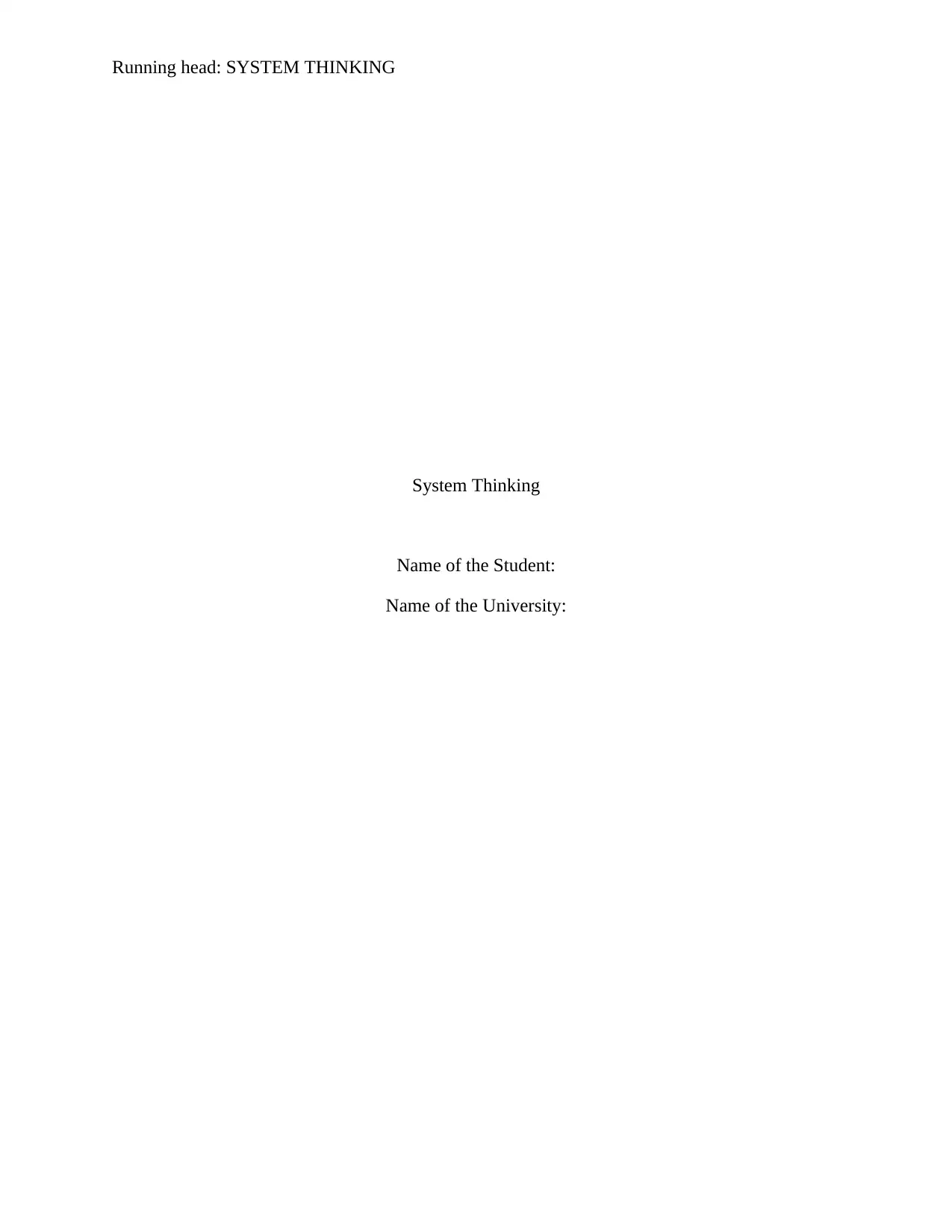
Running head: SYSTEM THINKING
System Thinking
Name of the Student:
Name of the University:
System Thinking
Name of the Student:
Name of the University:
Paraphrase This Document
Need a fresh take? Get an instant paraphrase of this document with our AI Paraphraser
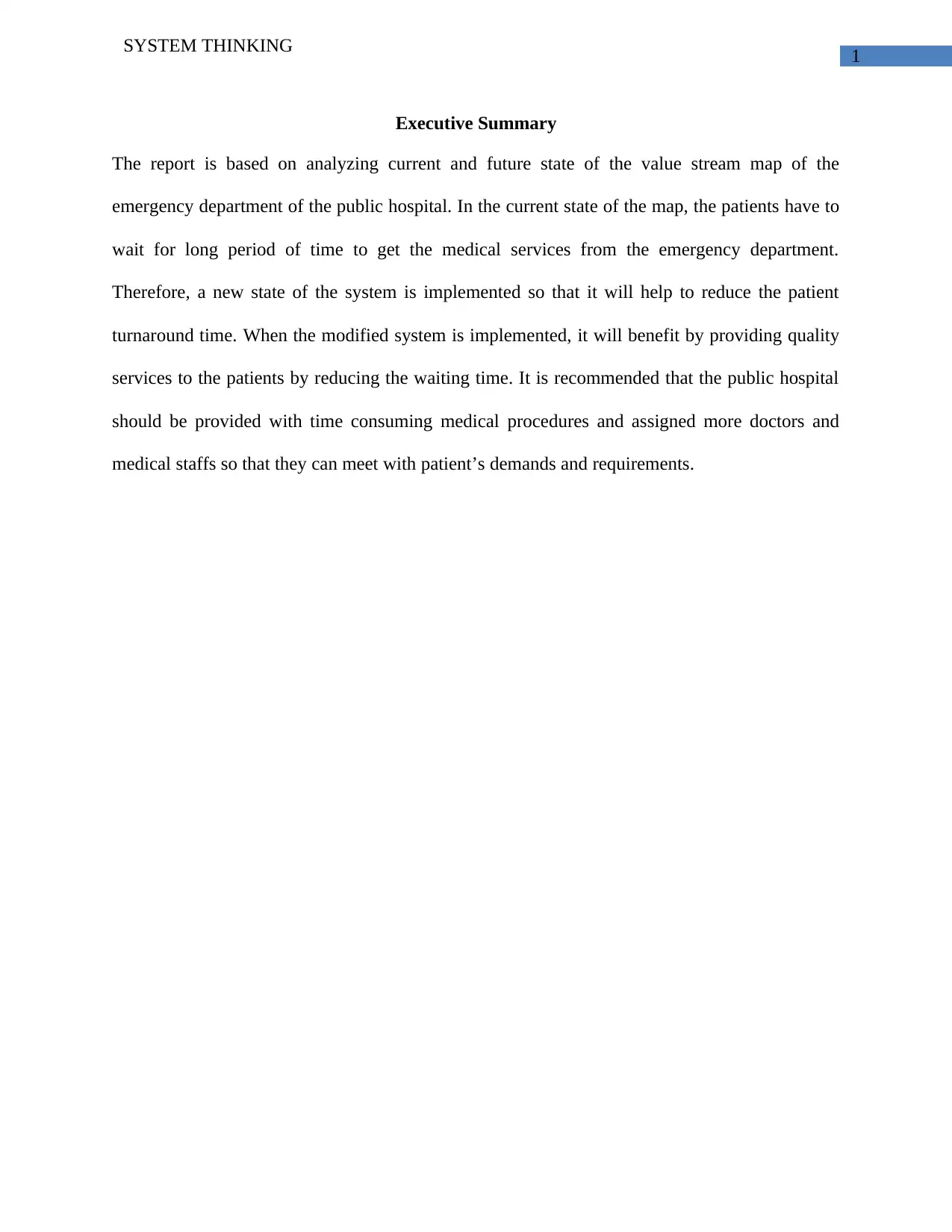
1
SYSTEM THINKING
Executive Summary
The report is based on analyzing current and future state of the value stream map of the
emergency department of the public hospital. In the current state of the map, the patients have to
wait for long period of time to get the medical services from the emergency department.
Therefore, a new state of the system is implemented so that it will help to reduce the patient
turnaround time. When the modified system is implemented, it will benefit by providing quality
services to the patients by reducing the waiting time. It is recommended that the public hospital
should be provided with time consuming medical procedures and assigned more doctors and
medical staffs so that they can meet with patient’s demands and requirements.
SYSTEM THINKING
Executive Summary
The report is based on analyzing current and future state of the value stream map of the
emergency department of the public hospital. In the current state of the map, the patients have to
wait for long period of time to get the medical services from the emergency department.
Therefore, a new state of the system is implemented so that it will help to reduce the patient
turnaround time. When the modified system is implemented, it will benefit by providing quality
services to the patients by reducing the waiting time. It is recommended that the public hospital
should be provided with time consuming medical procedures and assigned more doctors and
medical staffs so that they can meet with patient’s demands and requirements.
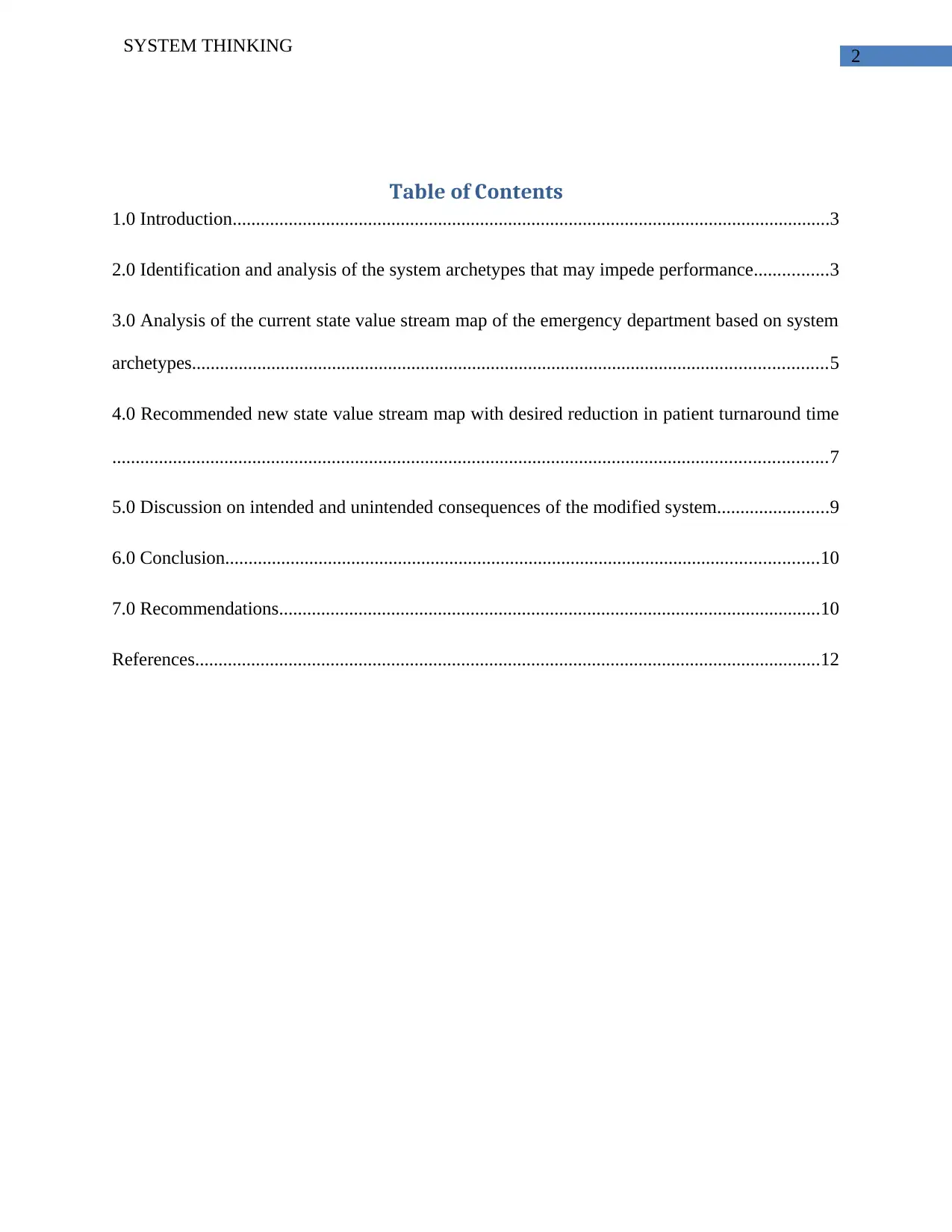
2
SYSTEM THINKING
Table of Contents
1.0 Introduction................................................................................................................................3
2.0 Identification and analysis of the system archetypes that may impede performance................3
3.0 Analysis of the current state value stream map of the emergency department based on system
archetypes........................................................................................................................................5
4.0 Recommended new state value stream map with desired reduction in patient turnaround time
.........................................................................................................................................................7
5.0 Discussion on intended and unintended consequences of the modified system........................9
6.0 Conclusion...............................................................................................................................10
7.0 Recommendations....................................................................................................................10
References......................................................................................................................................12
SYSTEM THINKING
Table of Contents
1.0 Introduction................................................................................................................................3
2.0 Identification and analysis of the system archetypes that may impede performance................3
3.0 Analysis of the current state value stream map of the emergency department based on system
archetypes........................................................................................................................................5
4.0 Recommended new state value stream map with desired reduction in patient turnaround time
.........................................................................................................................................................7
5.0 Discussion on intended and unintended consequences of the modified system........................9
6.0 Conclusion...............................................................................................................................10
7.0 Recommendations....................................................................................................................10
References......................................................................................................................................12
⊘ This is a preview!⊘
Do you want full access?
Subscribe today to unlock all pages.

Trusted by 1+ million students worldwide

3
SYSTEM THINKING
1.0 Introduction
The report is based on managing the operations of the emergency department of the
public hospital. The identified problem in the public hospital is that there is a high patient wait
time. The main purpose is to analyze the current value stream map of the public hospital by
improving the patient turnaround time by reducing current time to half. This problem is solved
by use of systems thinking tools called System Archetypes combined by means of the value
stream mapping. Archetypes are useful to gain insight in nature of the problem and offer basic
structure to develop and construct (Henrique et al., 2016). The Emergency Department plays a
key role to provide care to the patients and recognizes for contribution that they are making in
the society. The healthcare services are provided to the patients on 24*7 bases.
This particular report is based on identifying and analyzing the system archetypes that
may impede performance and analyzing the current state value stream map of the emergency
department. A new state of value stream map is also recommended in this report to reduce
patient turnaround time. The report discusses intended and unintended consequences of the new
system for reduction of patient turnaround time.
2.0 Identification and analysis of the system archetypes that may impede
performance
Following are the system archetypes which may impede the performance in the
emergency department of the hospital such as:
SYSTEM THINKING
1.0 Introduction
The report is based on managing the operations of the emergency department of the
public hospital. The identified problem in the public hospital is that there is a high patient wait
time. The main purpose is to analyze the current value stream map of the public hospital by
improving the patient turnaround time by reducing current time to half. This problem is solved
by use of systems thinking tools called System Archetypes combined by means of the value
stream mapping. Archetypes are useful to gain insight in nature of the problem and offer basic
structure to develop and construct (Henrique et al., 2016). The Emergency Department plays a
key role to provide care to the patients and recognizes for contribution that they are making in
the society. The healthcare services are provided to the patients on 24*7 bases.
This particular report is based on identifying and analyzing the system archetypes that
may impede performance and analyzing the current state value stream map of the emergency
department. A new state of value stream map is also recommended in this report to reduce
patient turnaround time. The report discusses intended and unintended consequences of the new
system for reduction of patient turnaround time.
2.0 Identification and analysis of the system archetypes that may impede
performance
Following are the system archetypes which may impede the performance in the
emergency department of the hospital such as:
Paraphrase This Document
Need a fresh take? Get an instant paraphrase of this document with our AI Paraphraser
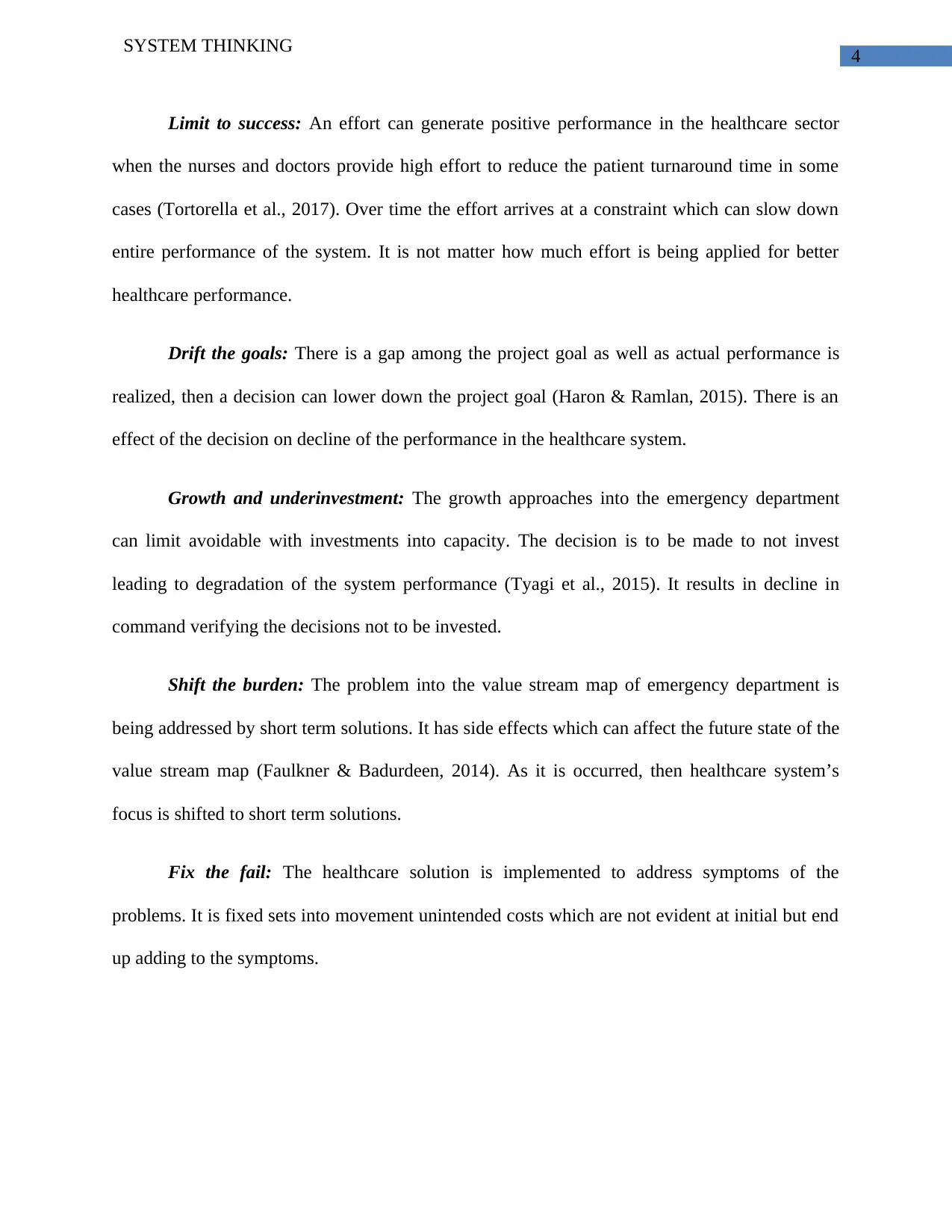
4
SYSTEM THINKING
Limit to success: An effort can generate positive performance in the healthcare sector
when the nurses and doctors provide high effort to reduce the patient turnaround time in some
cases (Tortorella et al., 2017). Over time the effort arrives at a constraint which can slow down
entire performance of the system. It is not matter how much effort is being applied for better
healthcare performance.
Drift the goals: There is a gap among the project goal as well as actual performance is
realized, then a decision can lower down the project goal (Haron & Ramlan, 2015). There is an
effect of the decision on decline of the performance in the healthcare system.
Growth and underinvestment: The growth approaches into the emergency department
can limit avoidable with investments into capacity. The decision is to be made to not invest
leading to degradation of the system performance (Tyagi et al., 2015). It results in decline in
command verifying the decisions not to be invested.
Shift the burden: The problem into the value stream map of emergency department is
being addressed by short term solutions. It has side effects which can affect the future state of the
value stream map (Faulkner & Badurdeen, 2014). As it is occurred, then healthcare system’s
focus is shifted to short term solutions.
Fix the fail: The healthcare solution is implemented to address symptoms of the
problems. It is fixed sets into movement unintended costs which are not evident at initial but end
up adding to the symptoms.
SYSTEM THINKING
Limit to success: An effort can generate positive performance in the healthcare sector
when the nurses and doctors provide high effort to reduce the patient turnaround time in some
cases (Tortorella et al., 2017). Over time the effort arrives at a constraint which can slow down
entire performance of the system. It is not matter how much effort is being applied for better
healthcare performance.
Drift the goals: There is a gap among the project goal as well as actual performance is
realized, then a decision can lower down the project goal (Haron & Ramlan, 2015). There is an
effect of the decision on decline of the performance in the healthcare system.
Growth and underinvestment: The growth approaches into the emergency department
can limit avoidable with investments into capacity. The decision is to be made to not invest
leading to degradation of the system performance (Tyagi et al., 2015). It results in decline in
command verifying the decisions not to be invested.
Shift the burden: The problem into the value stream map of emergency department is
being addressed by short term solutions. It has side effects which can affect the future state of the
value stream map (Faulkner & Badurdeen, 2014). As it is occurred, then healthcare system’s
focus is shifted to short term solutions.
Fix the fail: The healthcare solution is implemented to address symptoms of the
problems. It is fixed sets into movement unintended costs which are not evident at initial but end
up adding to the symptoms.
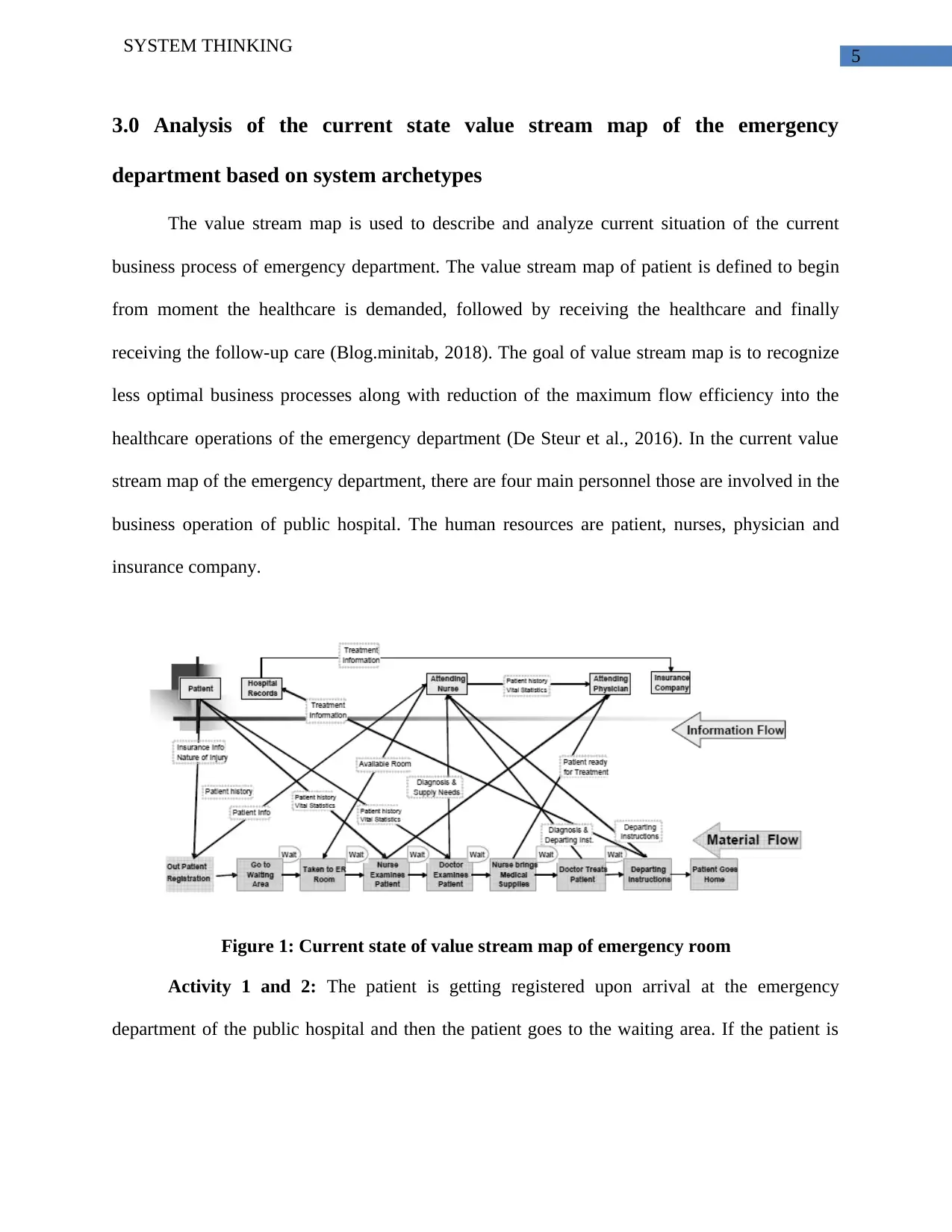
5
SYSTEM THINKING
3.0 Analysis of the current state value stream map of the emergency
department based on system archetypes
The value stream map is used to describe and analyze current situation of the current
business process of emergency department. The value stream map of patient is defined to begin
from moment the healthcare is demanded, followed by receiving the healthcare and finally
receiving the follow-up care (Blog.minitab, 2018). The goal of value stream map is to recognize
less optimal business processes along with reduction of the maximum flow efficiency into the
healthcare operations of the emergency department (De Steur et al., 2016). In the current value
stream map of the emergency department, there are four main personnel those are involved in the
business operation of public hospital. The human resources are patient, nurses, physician and
insurance company.
Figure 1: Current state of value stream map of emergency room
Activity 1 and 2: The patient is getting registered upon arrival at the emergency
department of the public hospital and then the patient goes to the waiting area. If the patient is
SYSTEM THINKING
3.0 Analysis of the current state value stream map of the emergency
department based on system archetypes
The value stream map is used to describe and analyze current situation of the current
business process of emergency department. The value stream map of patient is defined to begin
from moment the healthcare is demanded, followed by receiving the healthcare and finally
receiving the follow-up care (Blog.minitab, 2018). The goal of value stream map is to recognize
less optimal business processes along with reduction of the maximum flow efficiency into the
healthcare operations of the emergency department (De Steur et al., 2016). In the current value
stream map of the emergency department, there are four main personnel those are involved in the
business operation of public hospital. The human resources are patient, nurses, physician and
insurance company.
Figure 1: Current state of value stream map of emergency room
Activity 1 and 2: The patient is getting registered upon arrival at the emergency
department of the public hospital and then the patient goes to the waiting area. If the patient is
⊘ This is a preview!⊘
Do you want full access?
Subscribe today to unlock all pages.

Trusted by 1+ million students worldwide
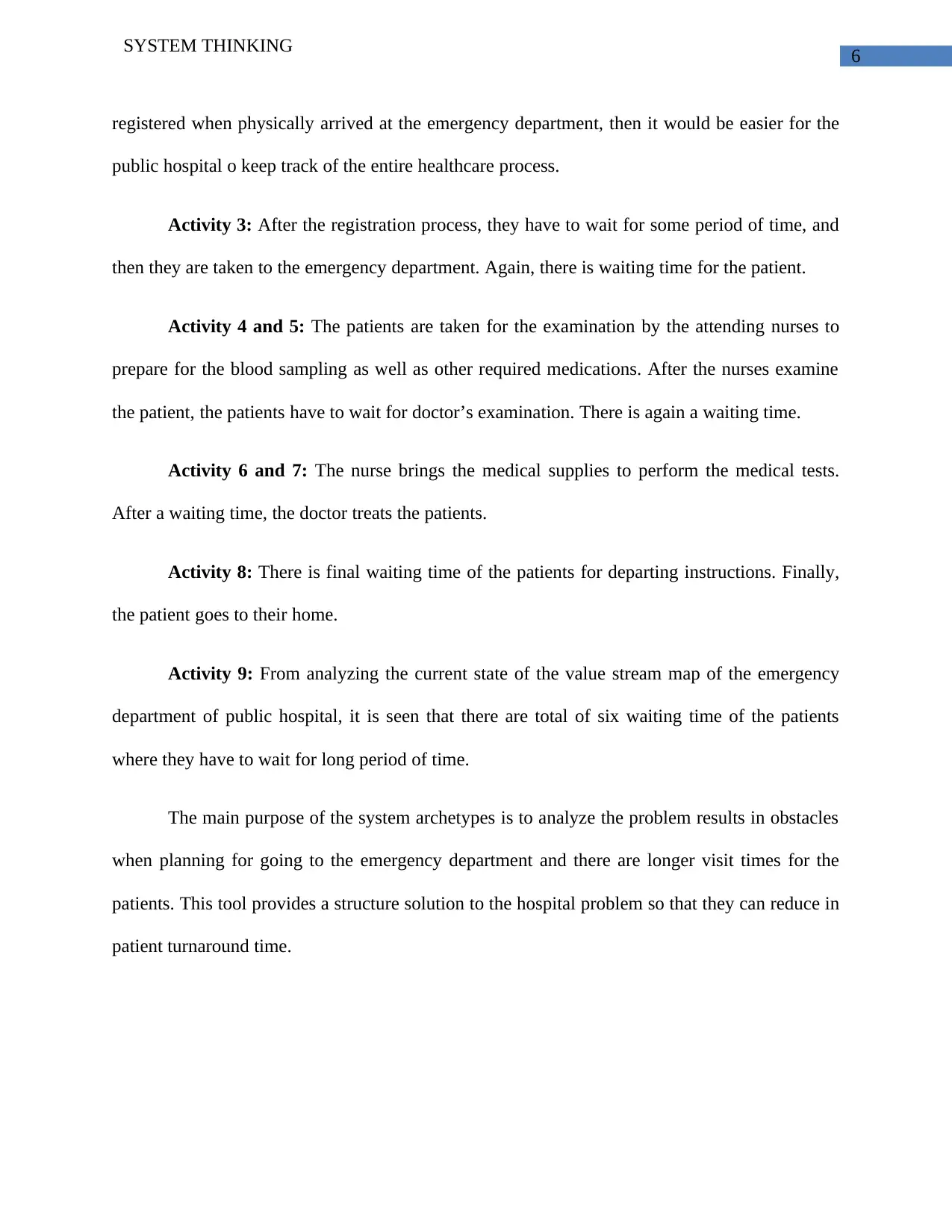
6
SYSTEM THINKING
registered when physically arrived at the emergency department, then it would be easier for the
public hospital o keep track of the entire healthcare process.
Activity 3: After the registration process, they have to wait for some period of time, and
then they are taken to the emergency department. Again, there is waiting time for the patient.
Activity 4 and 5: The patients are taken for the examination by the attending nurses to
prepare for the blood sampling as well as other required medications. After the nurses examine
the patient, the patients have to wait for doctor’s examination. There is again a waiting time.
Activity 6 and 7: The nurse brings the medical supplies to perform the medical tests.
After a waiting time, the doctor treats the patients.
Activity 8: There is final waiting time of the patients for departing instructions. Finally,
the patient goes to their home.
Activity 9: From analyzing the current state of the value stream map of the emergency
department of public hospital, it is seen that there are total of six waiting time of the patients
where they have to wait for long period of time.
The main purpose of the system archetypes is to analyze the problem results in obstacles
when planning for going to the emergency department and there are longer visit times for the
patients. This tool provides a structure solution to the hospital problem so that they can reduce in
patient turnaround time.
SYSTEM THINKING
registered when physically arrived at the emergency department, then it would be easier for the
public hospital o keep track of the entire healthcare process.
Activity 3: After the registration process, they have to wait for some period of time, and
then they are taken to the emergency department. Again, there is waiting time for the patient.
Activity 4 and 5: The patients are taken for the examination by the attending nurses to
prepare for the blood sampling as well as other required medications. After the nurses examine
the patient, the patients have to wait for doctor’s examination. There is again a waiting time.
Activity 6 and 7: The nurse brings the medical supplies to perform the medical tests.
After a waiting time, the doctor treats the patients.
Activity 8: There is final waiting time of the patients for departing instructions. Finally,
the patient goes to their home.
Activity 9: From analyzing the current state of the value stream map of the emergency
department of public hospital, it is seen that there are total of six waiting time of the patients
where they have to wait for long period of time.
The main purpose of the system archetypes is to analyze the problem results in obstacles
when planning for going to the emergency department and there are longer visit times for the
patients. This tool provides a structure solution to the hospital problem so that they can reduce in
patient turnaround time.
Paraphrase This Document
Need a fresh take? Get an instant paraphrase of this document with our AI Paraphraser
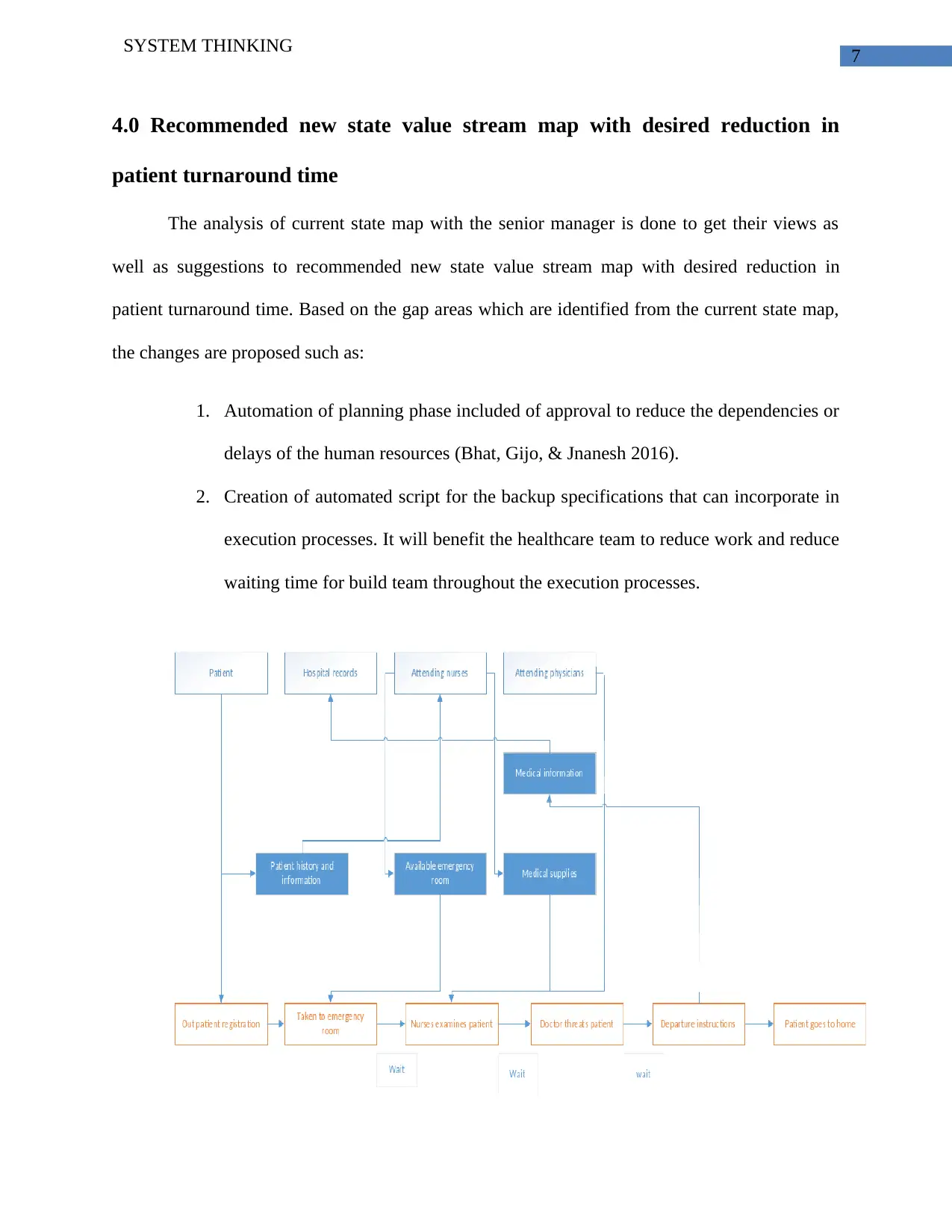
7
SYSTEM THINKING
4.0 Recommended new state value stream map with desired reduction in
patient turnaround time
The analysis of current state map with the senior manager is done to get their views as
well as suggestions to recommended new state value stream map with desired reduction in
patient turnaround time. Based on the gap areas which are identified from the current state map,
the changes are proposed such as:
1. Automation of planning phase included of approval to reduce the dependencies or
delays of the human resources (Bhat, Gijo, & Jnanesh 2016).
2. Creation of automated script for the backup specifications that can incorporate in
execution processes. It will benefit the healthcare team to reduce work and reduce
waiting time for build team throughout the execution processes.
SYSTEM THINKING
4.0 Recommended new state value stream map with desired reduction in
patient turnaround time
The analysis of current state map with the senior manager is done to get their views as
well as suggestions to recommended new state value stream map with desired reduction in
patient turnaround time. Based on the gap areas which are identified from the current state map,
the changes are proposed such as:
1. Automation of planning phase included of approval to reduce the dependencies or
delays of the human resources (Bhat, Gijo, & Jnanesh 2016).
2. Creation of automated script for the backup specifications that can incorporate in
execution processes. It will benefit the healthcare team to reduce work and reduce
waiting time for build team throughout the execution processes.
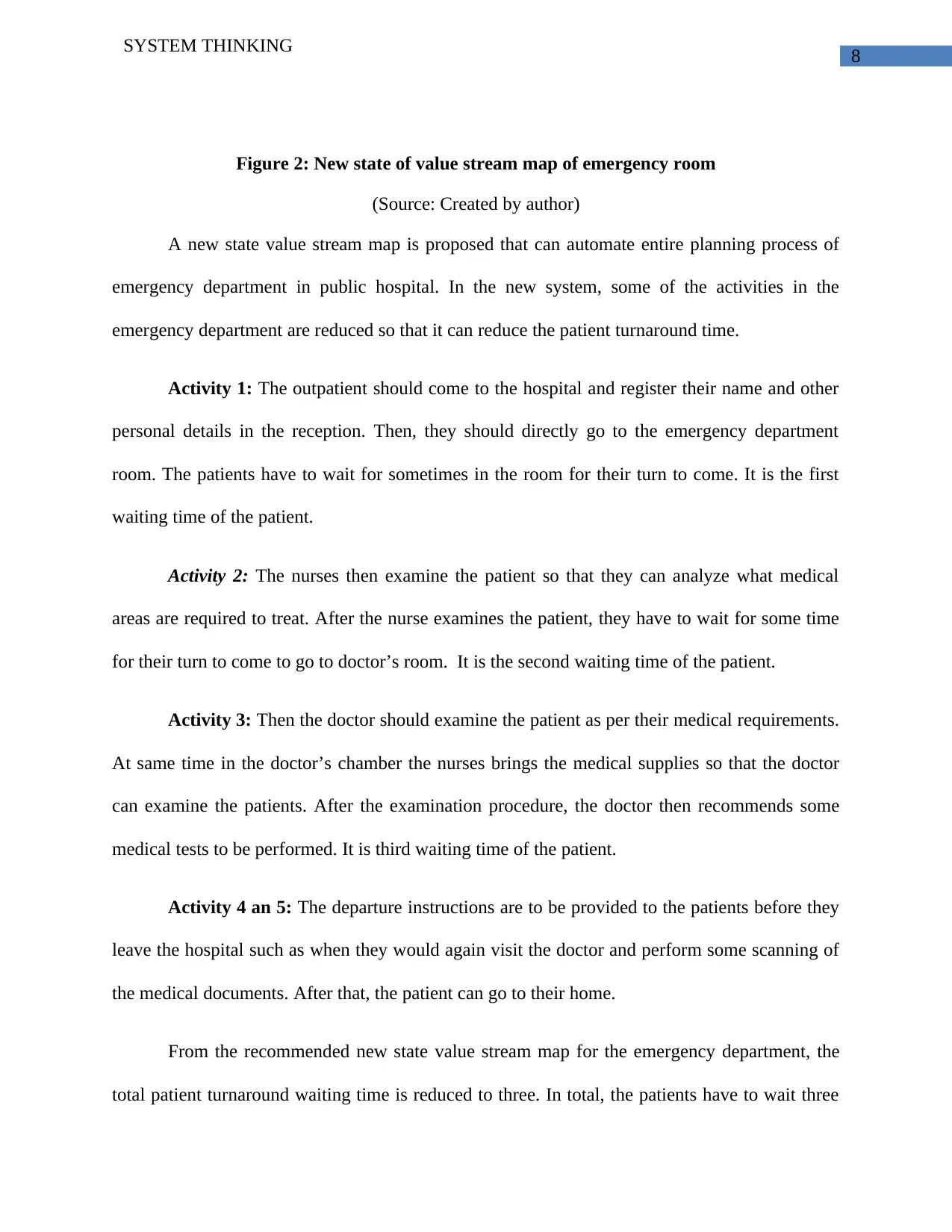
8
SYSTEM THINKING
Figure 2: New state of value stream map of emergency room
(Source: Created by author)
A new state value stream map is proposed that can automate entire planning process of
emergency department in public hospital. In the new system, some of the activities in the
emergency department are reduced so that it can reduce the patient turnaround time.
Activity 1: The outpatient should come to the hospital and register their name and other
personal details in the reception. Then, they should directly go to the emergency department
room. The patients have to wait for sometimes in the room for their turn to come. It is the first
waiting time of the patient.
Activity 2: The nurses then examine the patient so that they can analyze what medical
areas are required to treat. After the nurse examines the patient, they have to wait for some time
for their turn to come to go to doctor’s room. It is the second waiting time of the patient.
Activity 3: Then the doctor should examine the patient as per their medical requirements.
At same time in the doctor’s chamber the nurses brings the medical supplies so that the doctor
can examine the patients. After the examination procedure, the doctor then recommends some
medical tests to be performed. It is third waiting time of the patient.
Activity 4 an 5: The departure instructions are to be provided to the patients before they
leave the hospital such as when they would again visit the doctor and perform some scanning of
the medical documents. After that, the patient can go to their home.
From the recommended new state value stream map for the emergency department, the
total patient turnaround waiting time is reduced to three. In total, the patients have to wait three
SYSTEM THINKING
Figure 2: New state of value stream map of emergency room
(Source: Created by author)
A new state value stream map is proposed that can automate entire planning process of
emergency department in public hospital. In the new system, some of the activities in the
emergency department are reduced so that it can reduce the patient turnaround time.
Activity 1: The outpatient should come to the hospital and register their name and other
personal details in the reception. Then, they should directly go to the emergency department
room. The patients have to wait for sometimes in the room for their turn to come. It is the first
waiting time of the patient.
Activity 2: The nurses then examine the patient so that they can analyze what medical
areas are required to treat. After the nurse examines the patient, they have to wait for some time
for their turn to come to go to doctor’s room. It is the second waiting time of the patient.
Activity 3: Then the doctor should examine the patient as per their medical requirements.
At same time in the doctor’s chamber the nurses brings the medical supplies so that the doctor
can examine the patients. After the examination procedure, the doctor then recommends some
medical tests to be performed. It is third waiting time of the patient.
Activity 4 an 5: The departure instructions are to be provided to the patients before they
leave the hospital such as when they would again visit the doctor and perform some scanning of
the medical documents. After that, the patient can go to their home.
From the recommended new state value stream map for the emergency department, the
total patient turnaround waiting time is reduced to three. In total, the patients have to wait three
⊘ This is a preview!⊘
Do you want full access?
Subscribe today to unlock all pages.

Trusted by 1+ million students worldwide
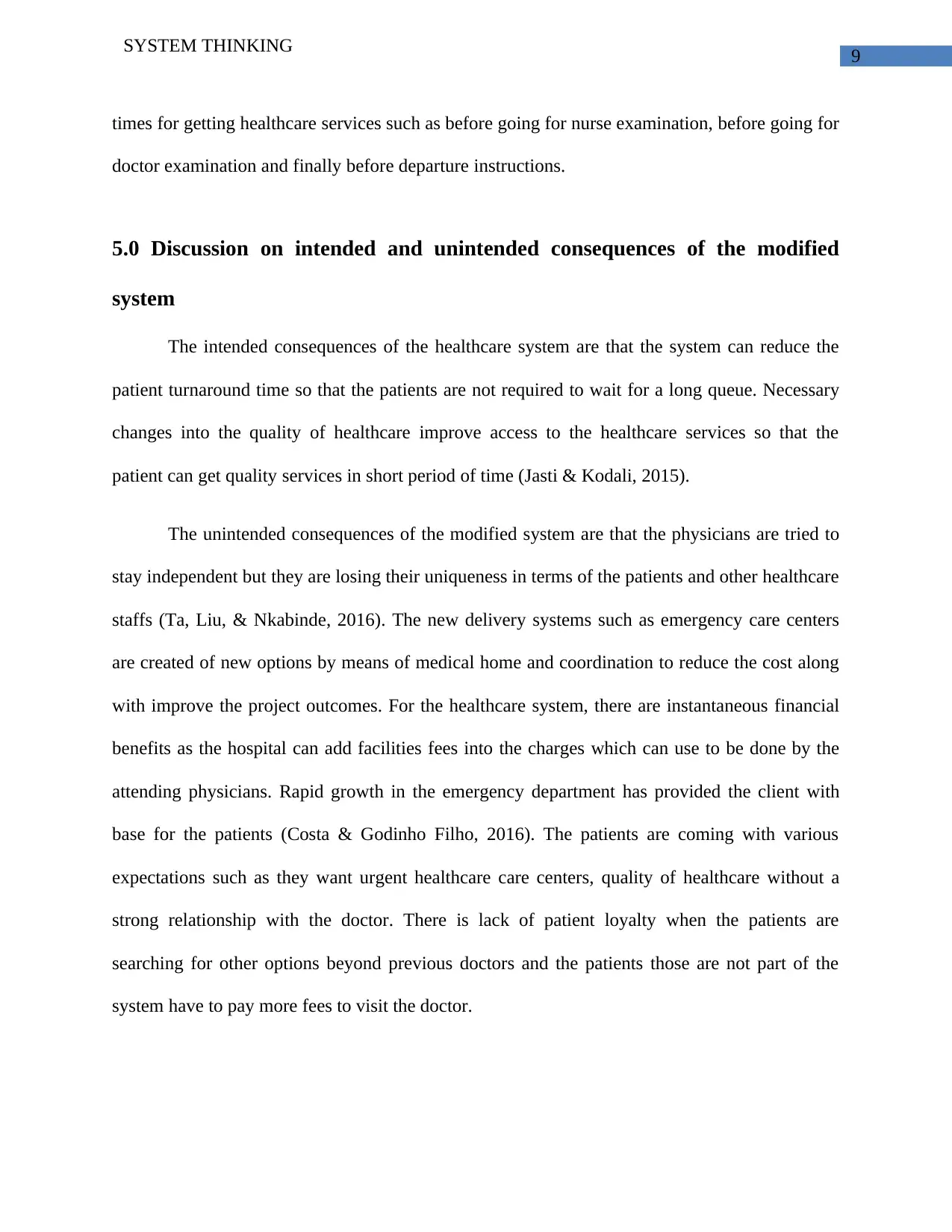
9
SYSTEM THINKING
times for getting healthcare services such as before going for nurse examination, before going for
doctor examination and finally before departure instructions.
5.0 Discussion on intended and unintended consequences of the modified
system
The intended consequences of the healthcare system are that the system can reduce the
patient turnaround time so that the patients are not required to wait for a long queue. Necessary
changes into the quality of healthcare improve access to the healthcare services so that the
patient can get quality services in short period of time (Jasti & Kodali, 2015).
The unintended consequences of the modified system are that the physicians are tried to
stay independent but they are losing their uniqueness in terms of the patients and other healthcare
staffs (Ta, Liu, & Nkabinde, 2016). The new delivery systems such as emergency care centers
are created of new options by means of medical home and coordination to reduce the cost along
with improve the project outcomes. For the healthcare system, there are instantaneous financial
benefits as the hospital can add facilities fees into the charges which can use to be done by the
attending physicians. Rapid growth in the emergency department has provided the client with
base for the patients (Costa & Godinho Filho, 2016). The patients are coming with various
expectations such as they want urgent healthcare care centers, quality of healthcare without a
strong relationship with the doctor. There is lack of patient loyalty when the patients are
searching for other options beyond previous doctors and the patients those are not part of the
system have to pay more fees to visit the doctor.
SYSTEM THINKING
times for getting healthcare services such as before going for nurse examination, before going for
doctor examination and finally before departure instructions.
5.0 Discussion on intended and unintended consequences of the modified
system
The intended consequences of the healthcare system are that the system can reduce the
patient turnaround time so that the patients are not required to wait for a long queue. Necessary
changes into the quality of healthcare improve access to the healthcare services so that the
patient can get quality services in short period of time (Jasti & Kodali, 2015).
The unintended consequences of the modified system are that the physicians are tried to
stay independent but they are losing their uniqueness in terms of the patients and other healthcare
staffs (Ta, Liu, & Nkabinde, 2016). The new delivery systems such as emergency care centers
are created of new options by means of medical home and coordination to reduce the cost along
with improve the project outcomes. For the healthcare system, there are instantaneous financial
benefits as the hospital can add facilities fees into the charges which can use to be done by the
attending physicians. Rapid growth in the emergency department has provided the client with
base for the patients (Costa & Godinho Filho, 2016). The patients are coming with various
expectations such as they want urgent healthcare care centers, quality of healthcare without a
strong relationship with the doctor. There is lack of patient loyalty when the patients are
searching for other options beyond previous doctors and the patients those are not part of the
system have to pay more fees to visit the doctor.
Paraphrase This Document
Need a fresh take? Get an instant paraphrase of this document with our AI Paraphraser
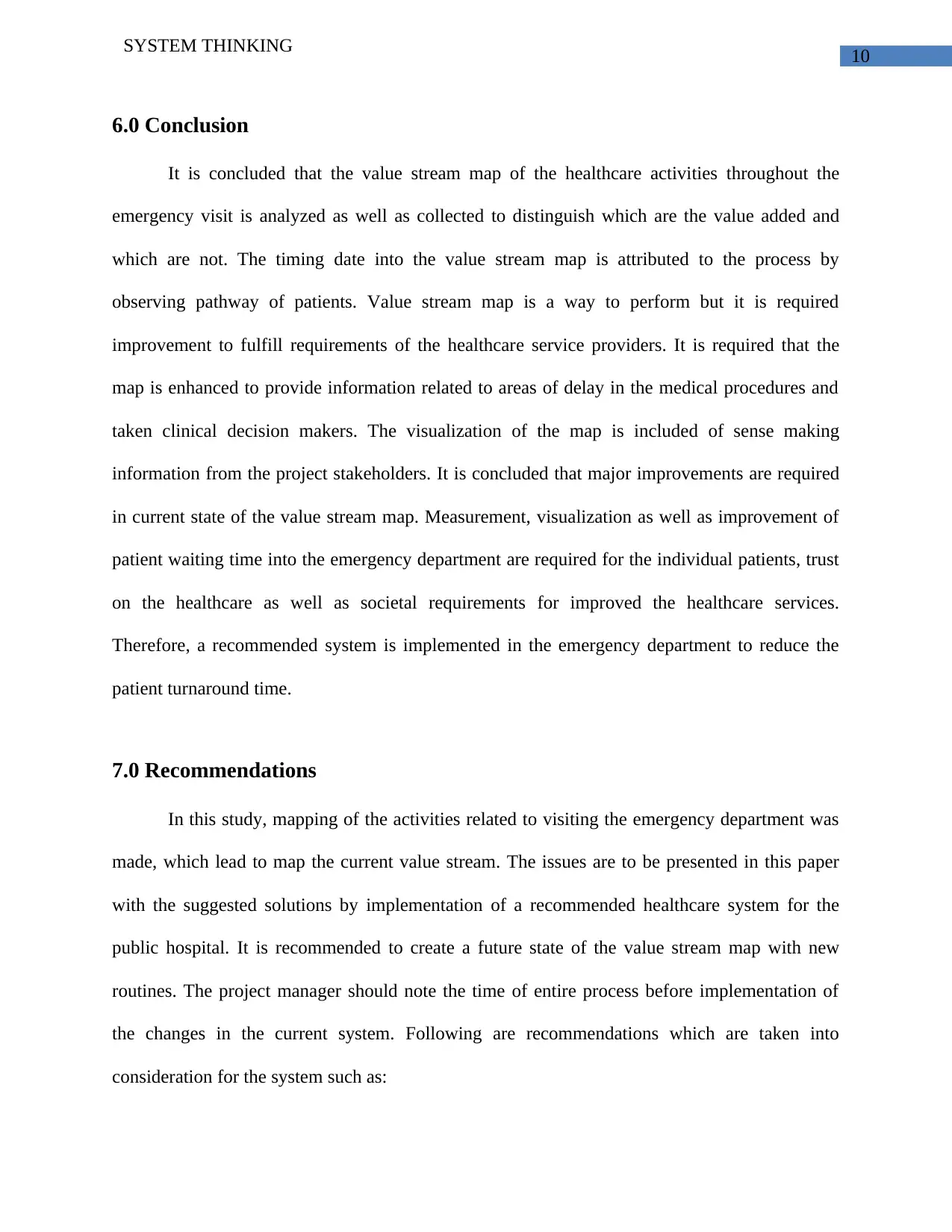
10
SYSTEM THINKING
6.0 Conclusion
It is concluded that the value stream map of the healthcare activities throughout the
emergency visit is analyzed as well as collected to distinguish which are the value added and
which are not. The timing date into the value stream map is attributed to the process by
observing pathway of patients. Value stream map is a way to perform but it is required
improvement to fulfill requirements of the healthcare service providers. It is required that the
map is enhanced to provide information related to areas of delay in the medical procedures and
taken clinical decision makers. The visualization of the map is included of sense making
information from the project stakeholders. It is concluded that major improvements are required
in current state of the value stream map. Measurement, visualization as well as improvement of
patient waiting time into the emergency department are required for the individual patients, trust
on the healthcare as well as societal requirements for improved the healthcare services.
Therefore, a recommended system is implemented in the emergency department to reduce the
patient turnaround time.
7.0 Recommendations
In this study, mapping of the activities related to visiting the emergency department was
made, which lead to map the current value stream. The issues are to be presented in this paper
with the suggested solutions by implementation of a recommended healthcare system for the
public hospital. It is recommended to create a future state of the value stream map with new
routines. The project manager should note the time of entire process before implementation of
the changes in the current system. Following are recommendations which are taken into
consideration for the system such as:
SYSTEM THINKING
6.0 Conclusion
It is concluded that the value stream map of the healthcare activities throughout the
emergency visit is analyzed as well as collected to distinguish which are the value added and
which are not. The timing date into the value stream map is attributed to the process by
observing pathway of patients. Value stream map is a way to perform but it is required
improvement to fulfill requirements of the healthcare service providers. It is required that the
map is enhanced to provide information related to areas of delay in the medical procedures and
taken clinical decision makers. The visualization of the map is included of sense making
information from the project stakeholders. It is concluded that major improvements are required
in current state of the value stream map. Measurement, visualization as well as improvement of
patient waiting time into the emergency department are required for the individual patients, trust
on the healthcare as well as societal requirements for improved the healthcare services.
Therefore, a recommended system is implemented in the emergency department to reduce the
patient turnaround time.
7.0 Recommendations
In this study, mapping of the activities related to visiting the emergency department was
made, which lead to map the current value stream. The issues are to be presented in this paper
with the suggested solutions by implementation of a recommended healthcare system for the
public hospital. It is recommended to create a future state of the value stream map with new
routines. The project manager should note the time of entire process before implementation of
the changes in the current system. Following are recommendations which are taken into
consideration for the system such as:
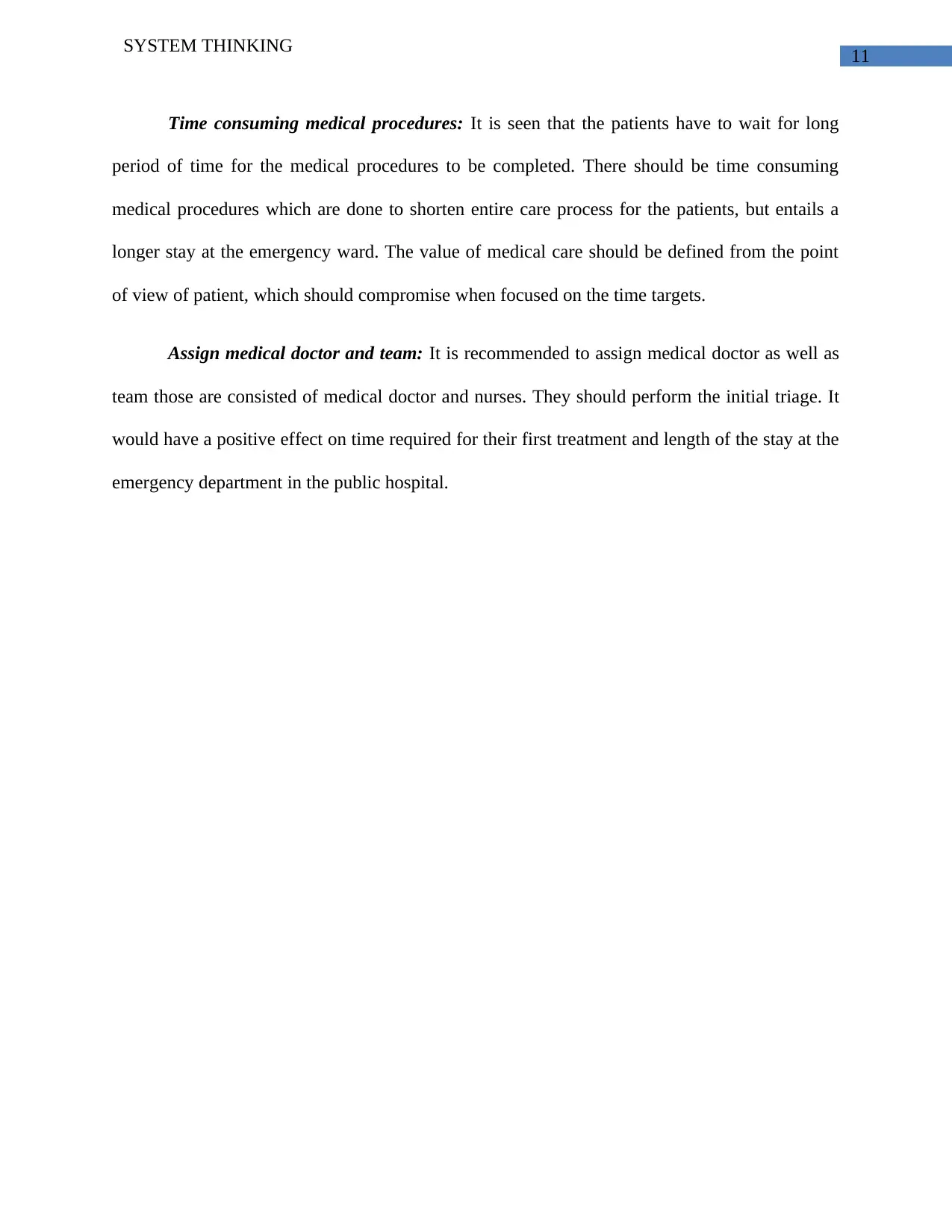
11
SYSTEM THINKING
Time consuming medical procedures: It is seen that the patients have to wait for long
period of time for the medical procedures to be completed. There should be time consuming
medical procedures which are done to shorten entire care process for the patients, but entails a
longer stay at the emergency ward. The value of medical care should be defined from the point
of view of patient, which should compromise when focused on the time targets.
Assign medical doctor and team: It is recommended to assign medical doctor as well as
team those are consisted of medical doctor and nurses. They should perform the initial triage. It
would have a positive effect on time required for their first treatment and length of the stay at the
emergency department in the public hospital.
SYSTEM THINKING
Time consuming medical procedures: It is seen that the patients have to wait for long
period of time for the medical procedures to be completed. There should be time consuming
medical procedures which are done to shorten entire care process for the patients, but entails a
longer stay at the emergency ward. The value of medical care should be defined from the point
of view of patient, which should compromise when focused on the time targets.
Assign medical doctor and team: It is recommended to assign medical doctor as well as
team those are consisted of medical doctor and nurses. They should perform the initial triage. It
would have a positive effect on time required for their first treatment and length of the stay at the
emergency department in the public hospital.
⊘ This is a preview!⊘
Do you want full access?
Subscribe today to unlock all pages.

Trusted by 1+ million students worldwide
1 out of 14
Related Documents
Your All-in-One AI-Powered Toolkit for Academic Success.
+13062052269
info@desklib.com
Available 24*7 on WhatsApp / Email
![[object Object]](/_next/static/media/star-bottom.7253800d.svg)
Unlock your academic potential
Copyright © 2020–2025 A2Z Services. All Rights Reserved. Developed and managed by ZUCOL.




